► CAR’s guest drive in the Audi Sport TT Cup
► Audi’s proving ground for young drivers
► Our Hockenheim experience in the meanest TT of all
We’re off to a bad start. ‘Three of you were late for this briefing. The first rule of being a professional racing driver is to be punctual. And some of you, your teamwear does not fit perfectly. Before the next round, you must visit a tailor.’
Welcome to the first day of a new term at Audi’s racing driver finishing school, where attention to detail is everything. It’s the opening round of the 2017 Audi Sport TT Cup at Hockenheim, and in a compact briefing room inside Audi’s hospitality mothership, championship manager Philipp Mondelaers is addressing the class: four rows of youthful drivers in identical Audi Sport clothing, and an apprehensive one in civvies. That would be me.
Now in its third season, the Audi Sport TT Cup is Audi’s proving ground for young driving talent: an ultra-competitive championship played out in identical cars over 14 races at seven circuits in three countries, on the same bill as the hugely popular DTM German touring car championship.
There are no individual teams; the cars are all prepared and run by Audi from its own pop-up pitlane within the DTM paddock. Think of it as the ultimate in arrive-and-drive racing. Testing is strictly limited, and other than tyre pressures and anti-roll bar swaps, no set-up changes are allowed – it’s all about the driver.
At each round Audi invites two guest drivers to take part, usually one journalist (which is how I’ve wound up here, intermittently pinching myself to make sure I really am) and one pro. So, in a surreal tableau, the name above the next garage to mine is Benoît Tréluyer, three-time Le Mans winner in Audi’s all-conquering World Endurance Championship programme – brought to a close last year as the wider VW Group tightened its purse strings.
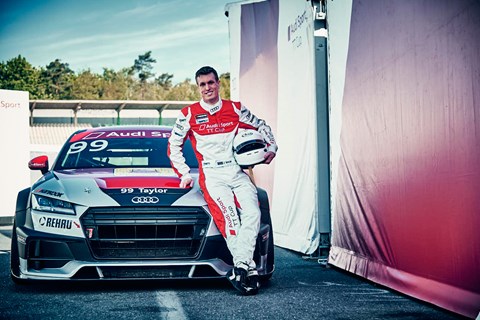
‘The TT Cup exists not to make money, but to find the next generation of drivers,’ says Chris Reinke, head of Audi Sport customer racing. ‘We are growing our next generation of customers within the brand.’ At the end of the season Audi will award a six-figure prize fund to the championship winner, intended to be spent progressing into the upper echelons of its customer racing programme.
But that doesn’t mean entry into the TT Cup is cheap. The cost for each driver is €120,000 for the season, plus a €10,000 deposit for damage. Despite the steep asking price, Audi had no fewer than 165 applicants for this season, whittled down to 16 drivers from all over the world, each aged between 16 and 24.
Think of it as a sort of X Factor for racing drivers. ‘It was like applying for a job,’ explains British driver Philip Ellis. ‘You had to show Audi why you would be the right person for the TT Cup.’ He’s one of two returning competitors from the previous season; the other is Poland’s Gosia Rdest, one of three female drivers on the grid.
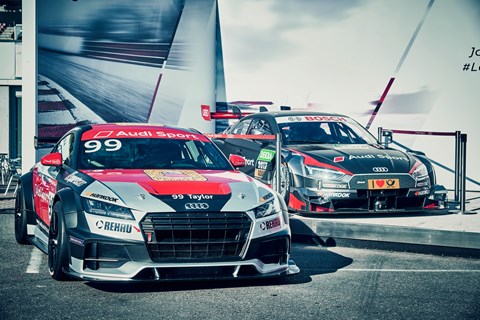
‘We were taken on a six-day fitness training course, where Audi’s team doctor gave us nutrition lessons, and even took blood tests,’ Jack Manchester, another Brit, tells me. ‘Then a pre-season practice day here at Hockenheim, to get familiar with the cars and practise the start procedure, which gave us all a chance to get to know each other.’ They’ve all bonded well, it seems; there’s plenty of good-natured joshing and comparing of notes. Young they might be (six of the drivers were born in 2000) but they’re used to racing at a high level.
Ellis bypassed karts and went straight to cars, climbing to Formula 3 before switching to tin-tops, while Drew Ridge was Australian karting champion and raced in Formula BMW Malaysia before moving to Munich to make a serious go of becoming a career driver. Milan Dontje was second in the Dutch GT championship and has raced LMP3 sports cars; 17-year-old Scot Finlay Hutchison is combining his TT Cup season with a GT campaign in a McLaren 570 GT4; and 18-year-old German Fabian Vettel is relatively new to cars, but his older brother has done quite a bit of racing. (You might have heard of him; his name’s Sebastian.)
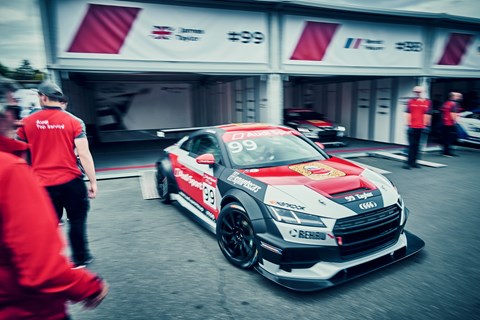
I’ve been fortunate to race and win in Ginettas and Radicals in my adventures for CAR at home, but this is a whole different, international, ball game. For one weekend, I’m racing with the big boys, even though not all of them are big, or boys. By rights, I should finish last. But it would be nice not to.
Clapping eyes on ‘my’ TT Cup car for the first time is quite a thrill. It might have started life as a regular TTS plucked from the production line, but this looks more mouth-wateringly purposeful than any TT I’ve seen before. The cambered wheels are pushed so far from the body they’re like outriggers. A jutting carbon splitter and giant rear wing karate-chop the air, and the road car’s kitsch fuel filler cap now covers a socket for the in-built air jacks.
Browse Audi TT cars for sale
Under the bonnet the production 2.0-litre TFSI four-cylinder engine remains virtually unchanged, with around 306bhp heading to the front wheels only – no quattro drive here. Gears are taken care of by the road car’s six-speed twin-clutch S-tronic gearbox, and there’s an electronically controlled limited-slip diff with three modes, toggled from one of many buttons on the steering wheel. ‘Start off on the most aggressive setting,’ the car’s mechanic Christian Aut advises, ‘then turn it down as the tyres wear, or if it’s raining.’
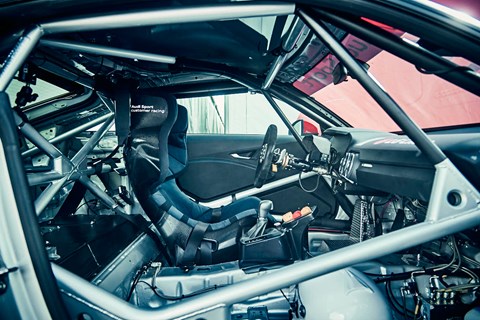
The road car’s leather-gaitered gear lever looks incongruous in the otherwise stripped-bare interior. Touch the dashboard moulding and it flexes forlornly without a centre console to support it. The four-pot turbo engine sounds smooth and burbly in the TTS road car, but rumbles like a truck in the Cup racer.
At first the whole car feels a bit truck-like, too, oddly inert and clumsy. Front-wheel-drive racing cars are curious creatures; the front slicks heat up quickly but the rears stay icy cold at first, making early laps something of an adventure. The Cup’s driver-coach Marco Werner (another three-time Le Mans winner) suggests keeping the traction control switched off for the early laps, so that if the rear tyres let go it’s possible to pull the car straight with a bootful of throttle.
Once the tyres are warm, though, the TT comes alive. It’s incredible just how hard you can punch the brake pedal, especially as the Cup cars feature ABS. As Werner points out, ABS actually limits braking performance rather than enhances it, and it takes skill to work the system to your advantage, knowing when to ease off. Compared to other racing cars, it feels odd, the TT shimmying on its toes as the system does its thing.
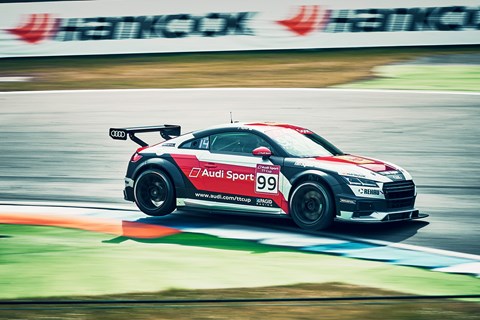
As I feel my way around, I try to remember Marco’s advice from the briefing; how you must wait until the tyres have come fully up to pressure before hitting the substantial ‘banana’ kerbs at full pelt, turn in early to the final section to ride the inside kerb with the inner wheels unloaded… My only previous experience of Hockenheim was on an ancient PlayStation game, and it’s an intensely atmospheric place in real life, fringed by thick forest and the towering grandstand structures that lend the Stadium complex its name.
‘When I raced here before the circuit was redesigned, it was a very special feeling coming into the Stadium from the old forest section,’ says Werner. ‘Alone in the trees, slipstreaming at full speed, and then suddenly there’s light, noise, crowds…’
Fast-forward to the end of qualifying and I’m still trying to get my head around the car and the circuit, and as predicted I’ve qualified at the back, but by an encouragingly small margin. Benoît Tréluyer wanders over to compare notes in parc fermé (and I plant another pinch on my increasingly bruised arm). ‘I got to the Stadium in the practice session and thought it was a different corner – whoah! – sideways across the gravel,’ he laughs. You’d like Benoît. I ask him if he’s driven the TT Cup car before. ‘No, no, the only time I’ve driven a front-wheel-drive car was a Renault R5, in a field, when I was 12. I’ve never been to Hockenheim before. [He still qualified seventh.] The main reason I came here was to see the World Rallycross,’ he jokes, conspiratorially.
Ah, yes. Not only are we on the same bill as the DTM, but the WRX too. They’re the rowdy neighbours at the other end of the paddock, their hose-down awnings a neat counterpoint to the DTM’s corporate gloss. Together with the rest of the TT Cup drivers and helpers, we’re based in the Audi Race Lounge for the weekend, a transportable structure of metal and glass, with a balcony overlooking the first corner and a bottomless supply of food and drink served by elegant waiting staff. That €120k entry fee is starting to add up. And there’s a separate unit for the Audi DTM team and its guests. ‘Last year it was bigger,’ a team-member tells me. ‘There was another floor.’
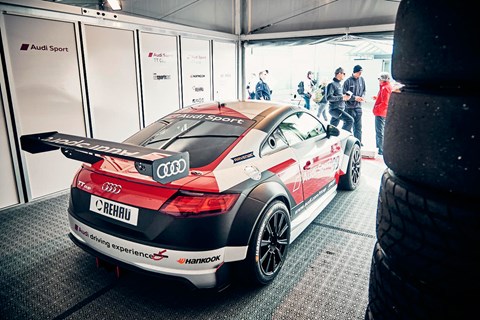
Time for race one of TT Cup 2017. HANS device pinning my shoulders into the seat, noise-blocking radio earpieces making me feel as if my head’s underwater, mechanic Christian latches the window net into place (designed to keep errant arms inside in a crash) and jettisons the car from its air jacks with a hiss and a thump. Heading to the grid through a throng of cameramen and curious DTM fans, my heart rate ought to be off the charts but I’m oddly calm. I’m just a journalist, after all, so if I finish last it doesn’t matter – and if I don’t I’ll have exceeded expectations.
As the lights wink into place on the Formula 1 start gantry, I engage launch control: left foot on the brake plus right foot flat on the throttle, subtract left foot when the lights go out. This is it. The opening laps are a blur of caught cold-tyre slides, latching onto the cars ahead and picking up some positions as a few of them run wide. I’m fully expecting the pack to gradually stretch into the distance, but halfway through the race I’m still with them. I’m not last. I can do this. It’s one of the best feelings I’ve ever had.
Then there’s a safety car to recover a stricken TT after a tangle at the infamous hairpin. It squeezes the field together like a concertina and I make a decent fist of the restart (Marco Werner gave the class a lesson on that very subject earlier in the day), but I change down one gear too many on the paddles into turn 2, then the system shifts up two at once as it catches up with my panicked pull on the other paddle – just as we enter the never-ending flat-out Parabolika curve.
I’m a sitting duck for the blue TT behind, which streams past with its ‘push-to-pass’ engaged. That’s a 30bhp shot of power that lasts for 15 seconds, triggered by a button on the steering wheel. Each driver gets 17 P2Ps to use during a race, with LED digits in the side window letting the crowds know how many they’ve got left. It’s as valuable a strategic tool for defending as it is for overtaking, and when it’s active a bright blue light glows in the windscreen to let the driver ahead know they’ve a fight on their hands.
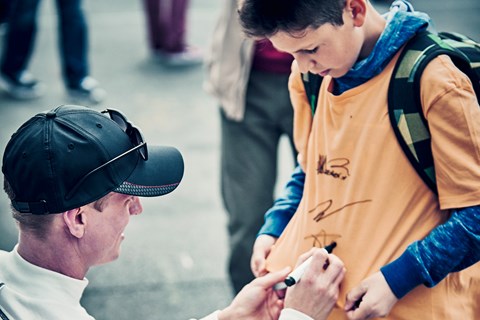
In the dying laps the situation’s reversed and I pull out of
the blue car’s slipstream to dive past into the hairpin, only for them to repass on the run to the next corner. I’d later find out it’s Fabian Vettel, who’s picked up a black flag for an earlier skirmish. He peels into the pitlane, allowing me to gradually close on ninth-placed Finlay Hutchison until the flag falls. Top 10!
We trickle back into the paddock and a heaving crowd gathers around the ticking TTs, several of which now carry light war wounds. I assume the fans will realise I’m not a pro when I fail to work out how to undo the window net to climb out, but the Audi race suit I’m wearing (complete with my name and a union flag; the TT Cup’s attention to detail is quite something) looks so professional some of them proffer marker pens for autographs. I don’t know the German for ‘I’m actually just a journalist’, and it seems more polite to sign and smile.
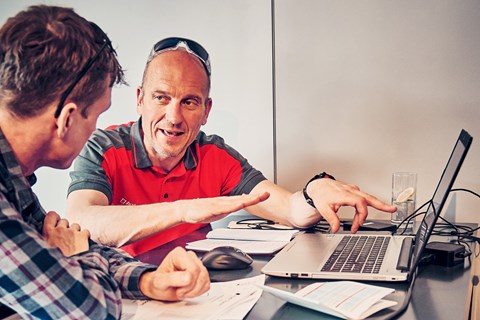
As for the full-time drivers, Philip Ellis has taken the win ahead of Gosia Rdest, with Tréluyer in fifth. They’re on a strict timetable of debriefs and interviews; after qualifying they were on stage in pressed white shirts to be introduced to world’s media, now they’re in red Audi Sport polo tops for data analysis with Audi’s race engineers. Data analyst Rolf kindly goes through my telemetry too, and openly laughs at my gentle brake pressure. In places I should be putting in as much as 30 bar extra – hitting the pedal as if I hate it. There’s still plenty more lap time to be unlocked in race two.
But the weather has other ideas. As a persistent drizzle falls, the DTM cars begin to slither around and the TT Cup organisers decide we must start race two on wet-weather tyres; no-one is allowed to take a gamble on slicks. It’s a hot day, though, and by the time we reach the grid the track is almost dry. This could be interesting.
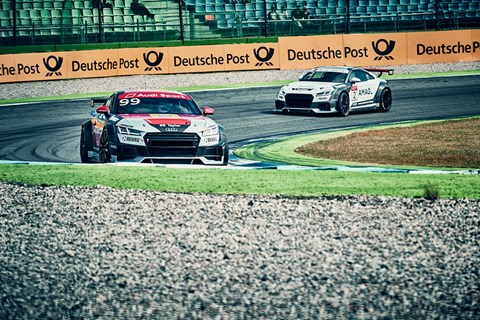
Traditionally, Audi TTs do not oversteer. For half an hour on a Sunday afternoon at Hockenheim, these ones do. The tyres begin to degrade to the point that chunks of rubber are pelting my windscreen and some cars even lose their wheelarch liners. Fingertip-smoothness is the order of the day to nurse the tyres to the end, and the whole field throws some spectacular shapes. While Ellis and Rdest again fight it out at the front, I enjoy a great battle with Jack Manchester, swapping positions nearly every lap. I’d ended the first race with some push-to-passes left, and you can’t carry them over to the next race. Keen not to make the same mistake again, this time I gobble through them all in the early laps like a kid with a bag of Haribo and I’m defenceless every time I see Jack’s windscreen turn blue in the mirrors. Eventually he runs out too and I make a move stick, crossing the line in P14 behind German Mike Beckhusen. I’m not last, again!
Whispers within the paddock are that this season will be the TT Cup’s last. Don’t be surprised to see the championship return with another model in the future, however. The Doctor Who of one-make racing, today’s TT Cup is the regenerated form of the VW Scirocco R Cup, itself an evolution of the original VW Lupo Cup, and its appeal is strong. Each TT Cup driver I speak to says they chose the series partly because of the careers built by previous graduates, and partly its direct link to Audi’s factory racing programmes.
After being in the eye of the incredibly slick Audi Sport storm for a weekend, I can see why. This is the lowest rung on Audi’s racing ladder, but even here the attention to detail that won Le Mans 13 times is entirely evident.
Whoever wins the 2017 TT Cup will be a driver with a hell of a skill set. And immaculate timekeeping to boot.
Words: James Taylor
Photography: Steffen Jahn
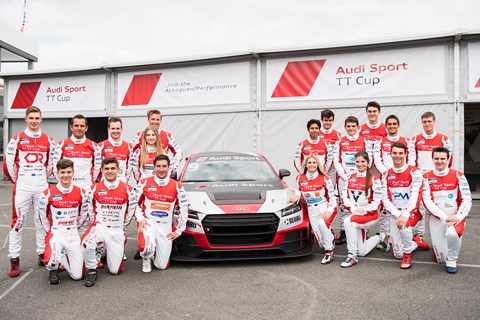
A weekend in the life of an Audi TT Cup driver
‘They even check your socks’ – life at Audi’s academy
Friday
- – 8.30am Morning briefing in strict team clothing: Adidas shoes, black Uvex trousers, red polo shirt, soft-shell jacket.
- – 8.45am Track walk with Marco Werner, literally giving us the inside line on Hockenheim.
- – 9.45am Race gear scrutineering. They check everything, including your socks.
- – 10.15am First of many driver briefings, and intro to the Audi team: stewards, mechanics, press officers, doctors…
- – 1.45pm Free practice.
- – 3.00pm Data analysis, and time to submit set-up requests to mechanics before qualifying.
- – 5.00pm Qualifying briefing, followed by a TV shoot for the regular drivers.
- – 6.30pm Dinner. Plenty of carbs and veg, impeccably prepared.
Saturday
- – 7.30am Breakfast.
- – 10.40am Qualifying.
- – 12.00pm Interviews on stage. Drivers to wear white team shirts and black trousers.
- – 2.30pm Hugely detailed race briefing with Marco Werner: how to line-up on the grid, where to watch out for cold tyres, how to handle a safety car restart…
- – 3.40pm Climb into cars, go to assembly area, get nervous.
- – 4.25pm Race 1.
- – 6.30pm Debrief and Q&A, going through footage from the race in detail.
- – 7.00pm Press interviews.
- – 8.00pm-on More data analysis, seeking vital tenths.
Sunday
- – 10.35am Public autograph sessions for the regular drivers.
- – 11.40am Final briefing.
- – 1.00pm Race 2.
- – 2.45pm Final debrief. Drivers are singled out as incidents from the race are reviewed. Overall? ‘We’re happy – it’s the best start we’ve had to TT Cup season yet.’
You can watch all of the 2017 Audi Sport TT Cup races here
Check out our gallery of the best fast Audi Sport RS Quattro cars here